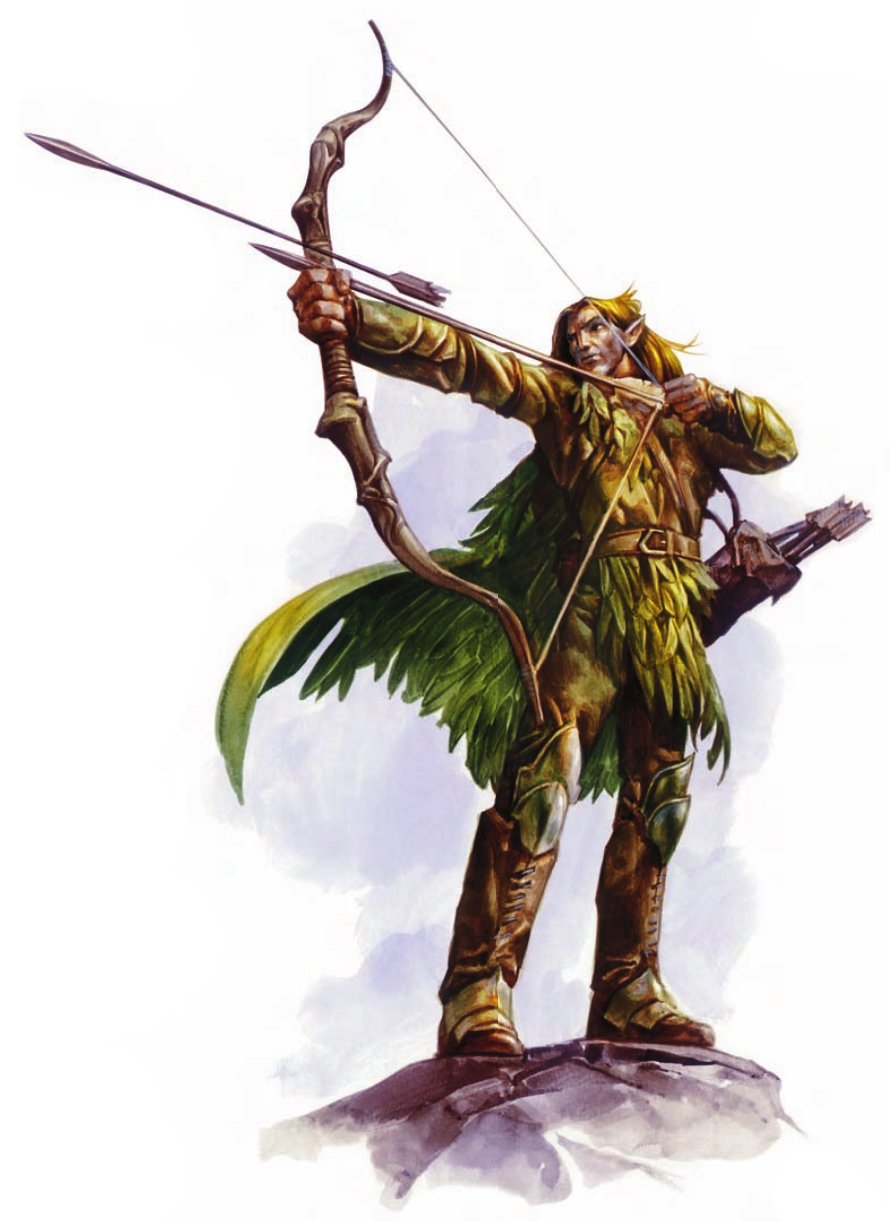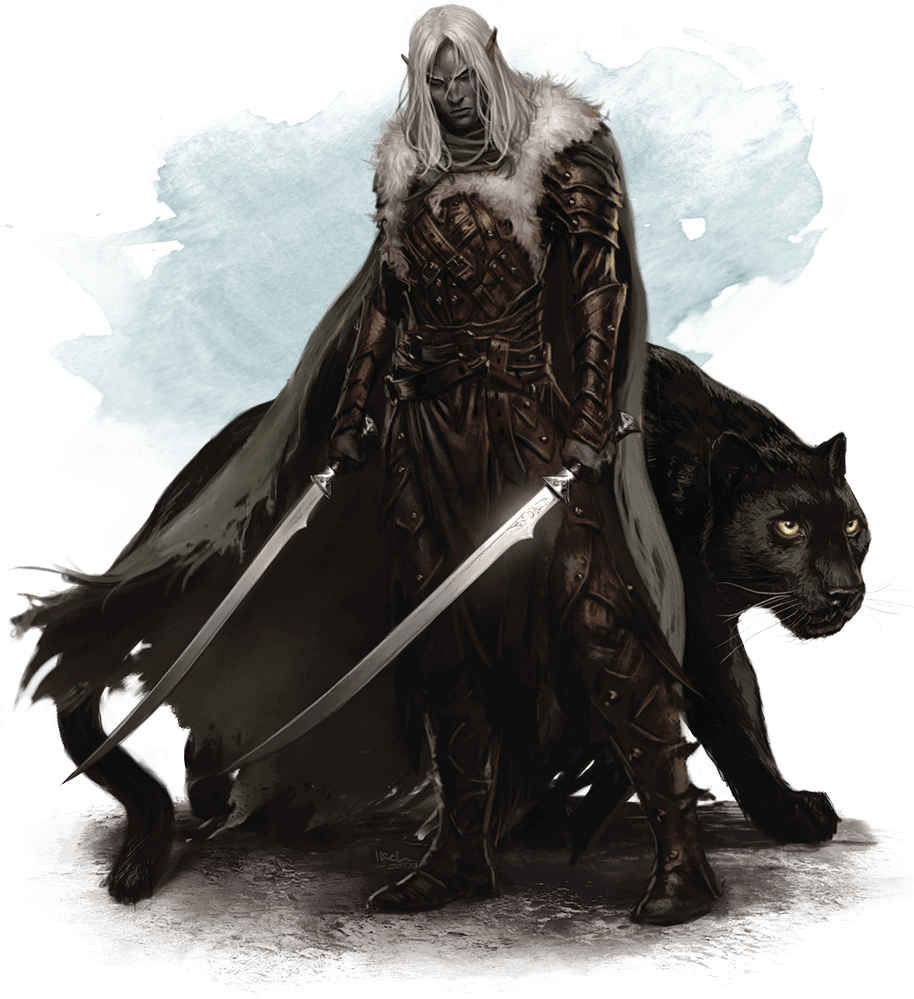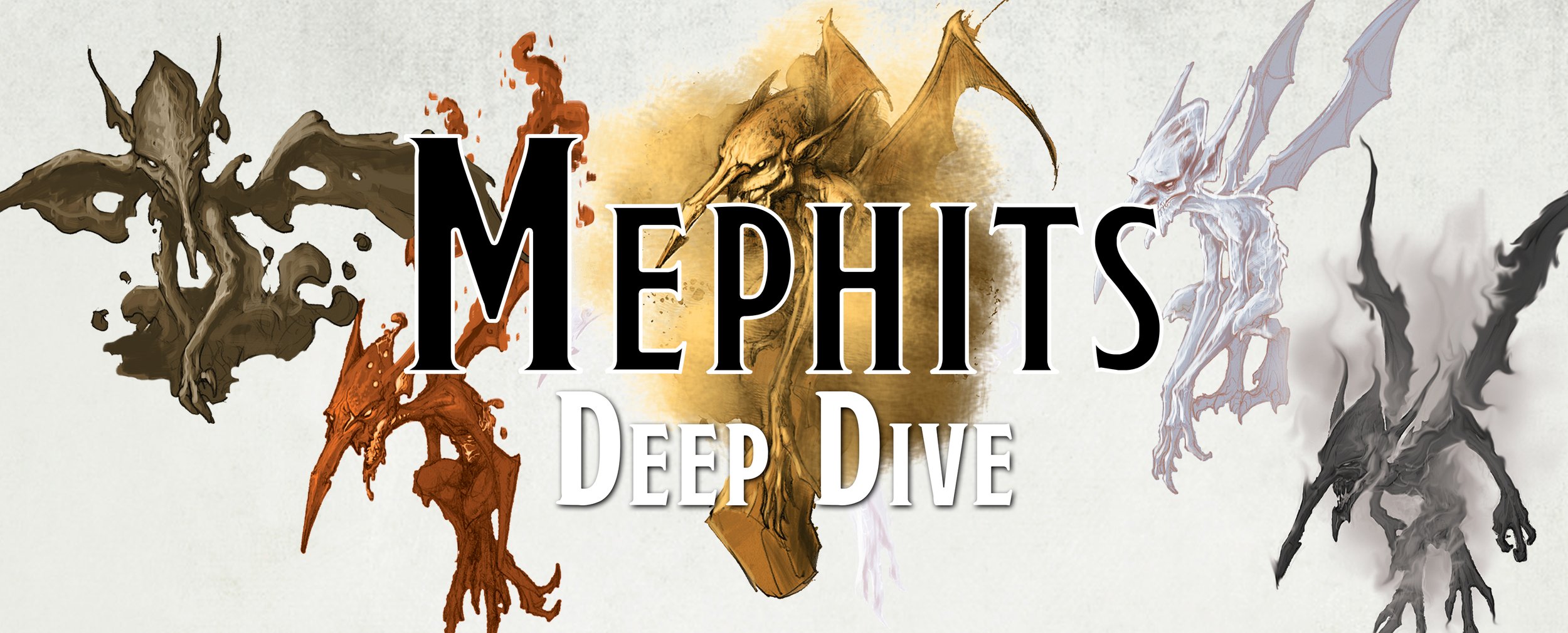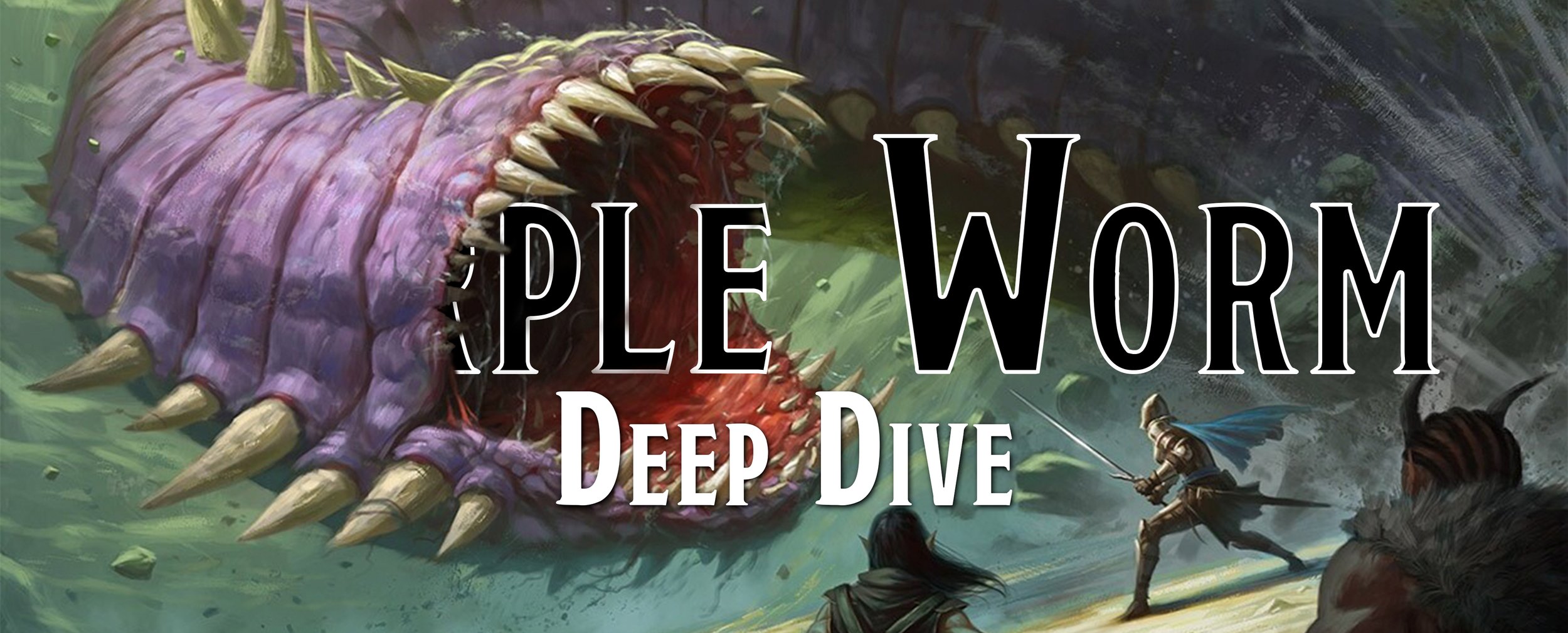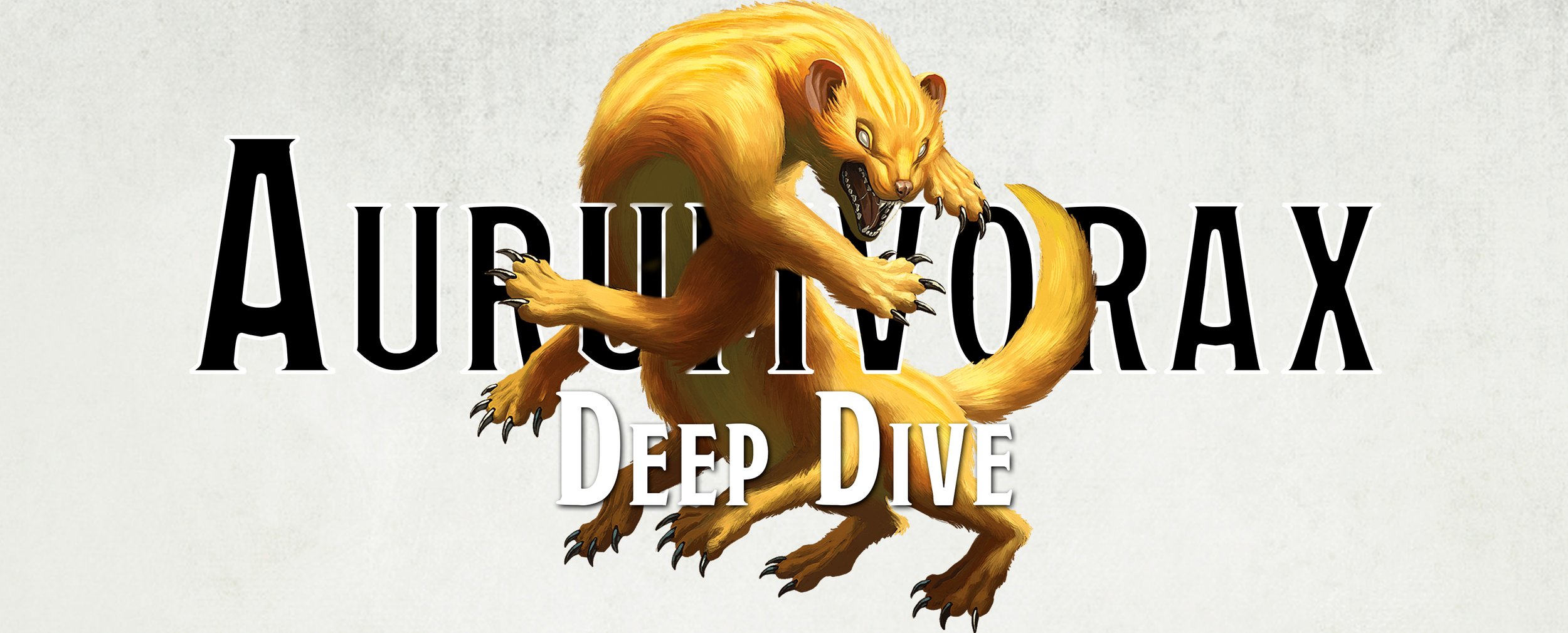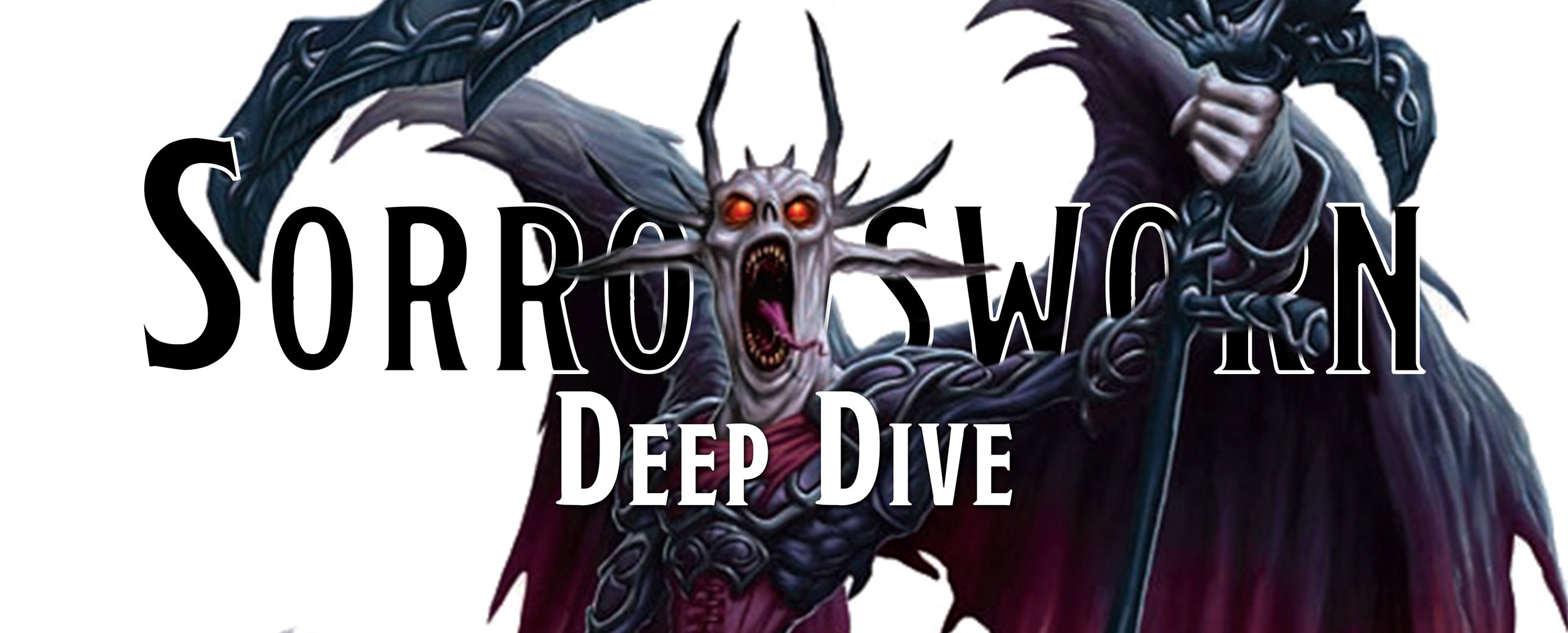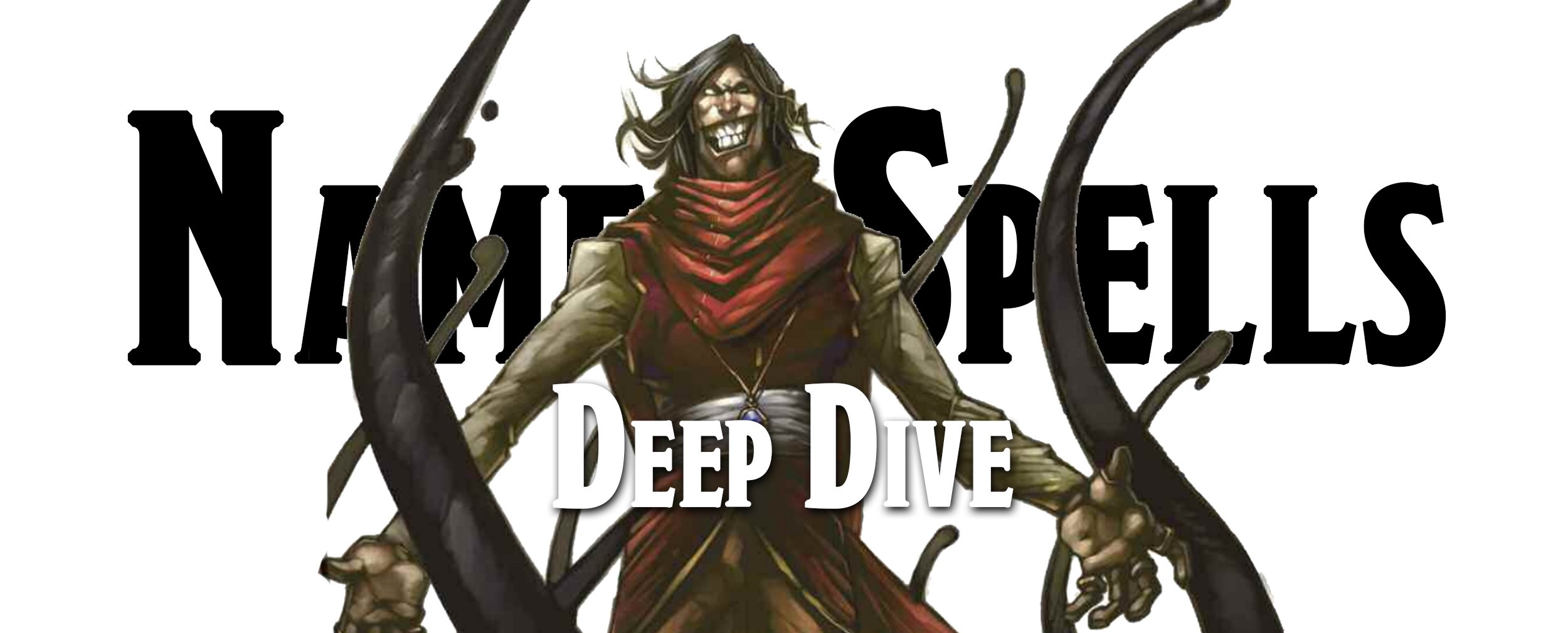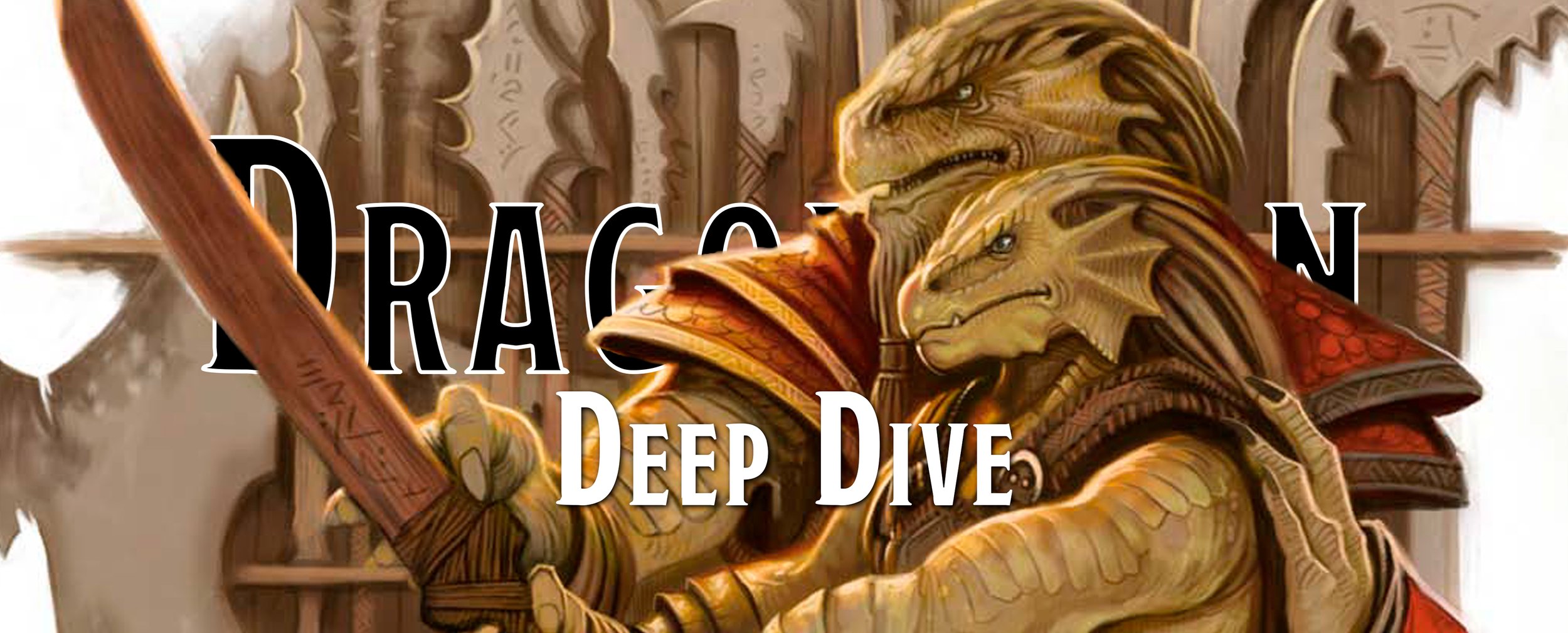Deep Dive - Ranger Class
It’s time to do another Deep Dive on one of the classes. This time around, we’ve decided to tackle the most divisive of all classes, the Ranger. People have extreme opinions on this class, with some believing that they should wield two swords and become a whirlwind of steel and blood, while others want to hide behind some bushes and pepper their enemies with arrows, and then still others want a fuzzy best friend to help them rip and tear their way through hordes of enemies.
So why do people heap so much hate on the Ranger? Let’s explore this class’s very beginnings and see how it has been shaped through the editions.
OD&D - Ranger
Key Features
• Hit Points: d6 (d8 if using the alternate system)
• Fighter sub-class
• Access to spells at 8th level
• Must be of lawful alignment
The Ranger is introduced in The Strategic Review Vol. 1, No. 2 (Summer, 1975) in an article written by Joe Fischer. Before we dive into it, we need to start by reminding you, dear reader, that this is the Original Dungeons & Dragons, and way back in 1975, fighters were called fighting men. We shall refer to them as fighters moving forward, and we apologize to all the purists out there.
Out the gate, the poor Ranger is a relatively weak subclass, and the designer, Fischer, even comes out and says it. That is, at least until the Ranger reaches 8th level when the Ranger gets access to their very first cleric spell. While we understand that Dungeons & Dragons was trying to come up with new ideas to draw as many people in as possible, it does seem kind of rude to just admit the Ranger is quite weak until you reach higher levels. The magic-user is basically useless after they cast their one spell for the day at level 1, but no one calls them a weak class while they still have a magic missile prepared.
So what makes this subclass bad? Well, the first thing you should be aware of before you select this class is that you are going to need some very good ability scores. Since this edition wants you to roll 3d6 in order for each ability, you are going to have to get lucky. First, you need a high strength as that is your prime requisite ability and determines if you get bonus experience, and thus get levels faster, it also dictates your damage so you need that high. After that, you need your Intelligence and Wisdom to both be at least 12 while you need a Constitution of 15. If you think that’s easy, remember it’s only 3d6 not 4d6 drop the lowest. The average for 3d6 is 10, so you are going to have to get very lucky or have a very kind DM who will boost your scores to the minimum.
With all of these high ability scores, you’d think you’d be in great shape to cut some baddies down, but you aren’t. If you find treasure, don’t get too excited because a Ranger can only keep what they can carry, and nothing more. Any excess treasure or goods must be donated to a worthy cause, probably because you are supposed to be someone who strikes out into the wilderness with only what you can carry. Plus, there is no getting around this with a wagon or horse; it specifically states that you have to carry everything. This is a detriment as now you can’t keep a lot of money, can’t carry lots of equipment, can't keep all your single-use kitchen gadgets you find, or keep a lot of magic items to give you more options on your adventures.
Rangers are loners and cannot employ men-at-arms, servants, or aides, which might seem like a weird restriction in our current edition of the game. Back then having servants and others was a major focus as fighters wanted to build castles and clerics wanted to build temples. In addition, you’ll never see more than two Rangers at a time. We don’t know why, but it’s the rule. There can only be two who work together; we guess they just aren’t very good at listening to each other. Finally, all Rangers must be lawful and any change in your alignment immediately ends with you becoming a plain, old, boring fighter.
The Strategic Review Vol.1 , No.2, 1975 TSR Inc.
Of course, there has to be some trade-off for all of these restrictions. The Ranger gets several things that make them worth playing, like how they receive four experience points for every three they earn. While that seems… weird, all characters had different amounts of experience that they needed like fighting-men need 2,000 XP to reach 2nd level, a magic-user needs 2,500 XP, clerics need 1,500 XP, and Rangers needs 2,500 XP. After that, Rangers become very, very good at hunting giant-class creatures as they gain a bonus to their damage equal to their level against giant creatures like the noble kobold, elves, treants, gnomes, goblins, gnolls, orcs, and trolls. It’s a weird list.
Not only do you get bonus damage, you also become an expert tracker. This set of abilities are unique to the Ranger and allows them to find tracks in most locations, like finding footprints that go through a trap door, up or down a chimney, and more! If you are outside, Rangers have a 90% chance of following a trail, while in dungeons or indoors, it is only 65%.
Once the Ranger hits 8th level, the heavens part and the Ranger truly takes off as a powerful class. Their title is now Ranger-Knight, they lose the additional experience points they used to get, but now they get the divine power of a cleric. That’s right, you now get a whole 1st-level spell from the cleric spell list. Additional levels will grant you a 1st-level spell from the magic-user list. As you increase in might, you also get stronger cleric and magic-user spells up to 3rd-level which is quite good, even if you are 12th-level by the time that happens. In addition, at 9th level, you get up to 24 followers who just appear out of nowhere and are ready to follow you through thick and thin. These followers are not the common stock men-at-arms but an assortment of thieves, fighters, wizards, and clerics of up to 7th level. Treat them well, though, because once one of them dies, they can never be replaced. We aren’t quite sure why you can’t make new friends, but perhaps the pain of loss is just too great.
1st Edition - Ranger
Key Features
• Hit Points: d8 (at 1st level, they get two hit dice)
• Access to Druid and Magic-User spells
• Can wear any armor, wield any weapon
• Must be good alignment of any sort
Player’s Handbook, 1978 TSR Inc.
The Ranger is found in the Player's Handbook (1978) and retains its status as a subclass of the fighter. While the class is largely the same as before, there are quite a few minor tweaks made to them. They definitely feel like a good class now to pick from, so long as you can meet some prerequisites. First, you have to be good-aligned. It doesn’t matter if its neutral, lawful, or chaotic; so long as you stay good-aligned, you’ll make a good ranger. Though if that ever changes, you instead become a d8 hit die fighter and you can never regain your ranger powers. For whatever reason, being a bit more neutral in your disposition makes you forget how to track creatures, we guess.
Next up, you better have rolled well or brought your DM a bribe, as you are going to need some good rolls for your ability scores. You need to have at least a 13 in Strength and Intelligence and a 14 in Wisdom and Constitution. If you happen to get a 15 in Strength, Intelligence, and Wisdom, then you gain a 10% bonus to all experience points you earn. With so many attributes needing such high scores, we can’t imagine there were a lot of people who rolled all those required numbers, but at least the Dungeon Master’s Guide (1979) in this edition admits that 3d6 down the line makes for rather unplayable characters and recommends 4d6, drop the lowest.
Dragon #106, Feb. 1986 TSR Inc.
The next big change is that when you roll for your hit points for your freshly minted Ranger, you are going to switch things up. Instead of rolling a d10 for hit points, like a real fighter or the other fighter subclass, the paladin, would do, you instead get to roll 2d8. Rangers have a smaller hit die, a d8, but 1st level gives them 2d8 for their hit points while additional levels it is only 1d8. The ranger gains up to 11 hit dice during its glorious adventuring career, while other fighters have a maximum of 9 hit dice before they just start getting flat bonuses to their hit points. So, on average, you are going to have the same total amount of hit points as a fighter, 49 hit points, but you’ll start out with more hit points and only by 4th level will the fighter catch up with you, and then surpass you until you get to 10th level and catch up.
We also have several abilities from before, like the bonus damage against giant creatures like kobolds, gnolls, ettins, goblins, giants, ogres, orcs, and bugbears. At least now elves can rest easy knowing you aren’t going to confuse them for a horrific fire giant and rip them apart with raw fury. After that, your skills as a tracker continue, and your percentages of tracking creatures remain the same outside the dungeon and inside it. Of course, if you do track a creature, they may know they are being tracked and will attempt to surprise you with a sudden attack. Rangers can only be surprised 16.66% of the time, which simply means during a surprise ambush the Ranger rolls a d6 and if they roll a 2-6, they are not surprised, otherwise you better hope they attack your druid first.
The rest of the Ranger remains pretty much the same, except they now gain druid spells instead of cleric spells, and since druids are just subclasses of the cleric, the spells are virtually the same. The Ranger can now multiclass, albeit only as a Cleric/Ranger, and only half-elves can do this. The Ranger gets a gaggle of henchmen, but no replacement fills their shoes when they die. You can't have more than you can carry, so only keep your most treasured items, and no ‘donating’ it to your party members or else you stop being a Ranger. Also, Rangers can hang out in groups of three, so now it’s a crowd.
Dragon #94, Feb. 1985 TSR Inc.
In Dragon #94 (February 1985), Gygax rewrites the Ranger's tracking rules. The article is two pages of overly detailed charts on the chances a Ranger can track something. Your tracking options can vary widely. You start with a low-based chance of following your prey, with any number of environmental and situational circumstances changing your chances. The number of variables is mind-boggling. If you are a 5th level ranger tracking a giant class creature who's with four friends (+2% per creature) outside (10% per level + 10% base = 60%), on soft ground (20%), no real reason (-1%), and it started raining an hour ago (-20%); you'd have a…you do the math, we'll do the writing. If they go indoors, then you'll have to recalculate using all sorts of other factors. Thanks, Gary, for making an already convoluted system that much more confusing. These rules are then made official in Unearthed Arcana (1985), along with an adjusted list of giant type monsters from the Fiend Folio (1981) and Monster Manual II (1983). Luckily for elves and treants, they fail to make the list.
Dragon #106, Feb. 1986 TSR Inc.
Dragon #106 (February 1986) presents two articles that give the Ranger all sorts of new abilities and henchmen, filling out even more what a Ranger could do. In The Ranger Redefined by Deborah Christian, our tracker extraordinaire is buffed beyond belief when it comes to skills. The goal of this article was to make the Ranger truly its own, separate from just being a special fighter. It grants more skills associated with finding food, making shelter, find water, setting traps and snares, getting skilled in fishing, a few buffs for those who like to track, spying, scouting, animal lore, transportation methods, infiltration, and even disguising yourself with nature. Tables and charts are found all over the place, with each one a percentage of success based on a d100 roll. The Ranger is now one part fighter, one part rogue, and one part Lorax.
The second article, More Range for Rangers, by James Yates, presents us with, you guessed it, more tables to roll on! We are sensing a theme in this edition. There are so many tables throughout. It's bordering on obsession. Yates takes the followers' tables found in the Dungeon Master's Guide (1978) and expands upon them, probably more than is needed. You've got all the races, mounts, animals, creatures, and special creature tables that can determine what the Ranger's best buds will be. We'll take two 6th level half-elf fighters, a lion, a mastodon mount, a couple of pixies, a weretiger, and one silver dragon, please.
2nd Edition - Ranger
Key Features
• Hit Points: 1d10
• A dozen kits available
• Warrior Subclass
• Priest spells only
Player’s Handbook, 1989 TSR Inc.
The 2nd edition Player's Handbook (1989) presents a Ranger that goes through some significant changes. Our Ranger falls under the Warrior category but is no longer a subclass of the fighter seeing as how the fighter is a subclass of Warrior. The first thing that jumps out at us is the leveling table where the Ranger now has a chance to Hide in Shadow and Move Silently, which increases as the Ranger levels up. If that excites you, well slow down because, like always, there are a few restrictions.
You still have to be good-aligned, it doesn’t matter if you are chaotic, neutral, or lawful so long as it is overly good. If you willingly commit a single evil act, you immediately lose all your Ranger powers and become a fighter of an equal level. You can never revert back to being a Ranger, no matter how many trees you hug or forest fires you stop. If you commit an evil act, and perhaps you were forced into it or you didn’t realize it was evil until it happened, you stop gaining experience points. You must now complete an adventure where you cleanse yourself morally, like killing the person who made you commit the evil act or reversing whatever thing they did.
We still get our spells for the late game Ranger starting at 8th level, but now these spells are just for priest spells within the plant or animal spheres. We’ve talked about those spheres before with the cleric, but to put it simply, there are 16 spheres of influence like there are different schools of magic for the wizard. Each one focuses on a specific domain and includes things like Animal, Healing, Protection, Sun, or Weather; these spheres simply provide spell lists that you can choose from if you have access to that sphere, either from your deity or class. As a Ranger, you’ll only ever get up to 3rd-level spells, but at least you’ll have access to such spells as animal friendship, bless, barkskin, goodberry, hold animal, or plant growth.
Player’s Handbook, 1989 TSR Inc.
If you were hoping to hurt kobolds, elves, gnolls, and treants with the extra damage that Rangers get, we are sad to inform you that you have to pick one monster type. You don’t get access to the full group of giants, and your choice doesn’t even have to be limited to giants! Now you get to pick any type of creature, with the DM’s permission, and you get a bonus to your attack against them. Now if you truly hate elves, you can make sure you pick them as your most hated enemy. This does come with a small problem, where if you are trying to interact with them, you take a big penalty on your first impressions roll, meaning that your pure hatred for them could easily shine through, informing the elves that you are a no good meanie… plus the necklace of elven ears probably isn’t helping your case either.
Being a nature lover, this woodsman class has a few new abilities that make a lot of sense. They are good with animals, both that are trained and untrained. It's not like they are besties with all animals; instead they have a certain level of empathy towards them. This means our sword-wielding Lorax can be friendly instantly with any domesticated creature, like a cow or horse. For wild animals, like a lumbering bear or a furious squirrel, the animal has to make a save with a penalty based on what level Ranger you are, on a failed save they become indifferent or helpful to the Ranger based on their previous disposition. If you are thinking of forming a massive squirrel army to take over the forest, we suggest you watch out as everyone knows that squirrels are a nutty bunch.
While you still can’t hire henchman or mercenaries until you get to a high enough level, you at least get free minions that flock to you at 10th level. They trickle in over several months, so keep an eye out on the horizon for a gnome fighter or a treant heading your way. And don't be a jerk to them, or they may just pick up their toys and leave. Remember you are a good person since your alignment says you are, and you'll be a nice fellow toward everyone. If you do have a band of merry men, you can now provide them all with a lodging as you can build a castle, fort, or stronghold. Unfortunately, a castle is costly and you still can only keep what you can carry, so it sounds like it is going to be a very small castle or you are blinged out in rings and necklaces.
The Complete Ranger’s Handbook, 1993 TSR Inc.
The Complete Ranger's Handbook (1993) expands on the Ranger class more than anyone could hope for. There is way more information than time to go over them, so we'll touch on just a couple before moving on. Whether or not it's true, the introduction states that the Ranger is one of the most popular character classes in Advanced Dungeons & Dragons, so if the Ranger is your preferred class, we recommend picking up a copy. Much of the information expands on existing rules, but there's also a lot of new stuff. It's a great read, diving deep into the this edition’s version of the Ranger along with new regulations, skills, charts, followers, religions, and way more.
One such new addition to Rangers is the choice to take a kit, allowing for your Ranger to be a bit more unique than the others out in the woods. You can choose from twelve kits, each with particular traits and powers; they are the Beastmaster, Explorer, Falconer, Feralan, Forest Runner, Giant Killer, Greenwood Ranger, Guardian, Justifier, Mountain Man, Pathfinder, Sea Ranger, Seeker, Stalker, and Warden.
The Complete Ranger’s Handbook, 1993 TSR Inc.
The Beastmaster never gains humanoid henchmen and companions, but rather has a huge pack of animals that they gain a special bond with. The Explorer spends their time planning expeditions and traveling the world. Falconer is pretty obvious; you train and work with falcons. Feral's are were-creatures, which can cause them the be shunned by the common folk. Forest runners are essentially Robin Hood, experts in undoing evil empires through guerrilla tactics. Giant Killers, well, kill giants. A Greenwood Ranger is part human, part tree, so if you've ever wanted to be one with nature, here's your chance. Take the Guardian kit, and you genuinely are the Lorax, protecting the wilderness. Justifiers are action junkies, a specialist who deals with near-impossible tasks. The Mountain Man shuns civilized society, living in the wilds alone. Pathfinders can find the best routes to any place, so they are in high demand by merchants looking for new trade routes. Sea Rangers like boats, the ocean, and fish. Seekers are seeking enlightenment and think animals are the way to reach it. Stalkers make great spies, although they may have a few restraining orders against them. Finally, the Warden serves at the pleasure of a king or noble, protecting their lands from would-be hooligans and invaders.
Dragon #225, Jan. 1996 TSR Inc.
In Dragon #225 (Jan. 1996), we find the article Caste of Character by Michael Selinker. Here he introduces the Indian Ranger called Shikari. They are big game hunters, tracking and killing large animals and creatures, with special abilities that allow them to enter a trance and detect nearby animals immediately. The biggest thing is that they don’t have an alignment restriction; on the other hand you also need an Intelligence of 13, along with all the other prerequisites of being a Ranger, so it is a bit harder to take this kit compared to others.
Nine issues later, Dragon #234 (October 1996) debuts with two new kits in the article Crypt Rangers and Defenders by Ross Alan Clifton. The Crypt Ranger is a hunter/slayer of all things undead. Their primary goal is to protect the living from the dead, moving to wherever such a threat may be. They choose from the undead as their enemy, like skeletons or liches. As you would imagine, their abilities revolve around the undead and include detect undead, immunity to fear, and protection from evil. The Defender is the protector of the dead, not to be confused with undead. They have a single location they guard, killing would-be grave robbers from desecrating the resting place of those who have passed from this mortal coil. They are constantly alert for such dangers and can speak with the Dead if they need to gather information from those they seek to protect.
The Complete Ranger’s Handbook, 1993 TSR Inc.
3rd Edition - Ranger
Key Features
• Hit Points: 1d8
• Key Ability: Dexterity/Wisdom
• Can be any alignment
• Animal Companion now at 4th level
Player’s Handbook, 2003 WotC
Found in the Player's Handbook (2000/2003), the Ranger continues its slow and steady growth as a character class. Entirely out of the shadow of the other classes, Rangers stand on their own as a force to be reckoned with. Changes abound, and while none may be a seismic shift, they definitely define the Ranger for this edition.
Before we dive into this class, we need to take a quick look at the 3rd edition book Masters of the Wild (2002), which is a guideline for playing barbarians, druids, and of course, the Ranger. Rangers are depicted as a jack-of-all-trades, yet master of none, having casting abilities like spellcasters, can sneak and hide, wield weapons like fighters, and be attuned to nature like the druid. When you decide to play as a Ranger, your race matters, as each comes with its own unique bonuses.
Masters of the Wilds, 2002 WotC
We are excited to announce that there are no longer any prerequisites for being a Ranger. If you want to be evil and create all sorts of mayhem within in the forest, you are welcome to do so. In addition, you don’t have to worry about hitting the minimum ability scores to play this class, though you should keep an eye on your Wisdom as it determines what level spells you can cast once you hit 4th level in the class. You should get your Wisdom to at least a 14 to get access to 4th-level spells, or else you are leaving behind some strong abilities to help your beloved forest.
And you heard that right! No longer do you have to wait until the end of a year long campaign to get access to your spells, you get them at 4th level… if you have at least a 12 in Wisdom, otherwise you have to wait until 6th level and that point, well, you aren’t going to be getting any higher level spells unless you increase your Wisdom. In addition, there are none of those silly race restrictions or level caps from before, if you want to play as a half-elf Ranger, you can reach level 20 just like a real human!
We still have the Ranger’s ability to hurt very specific creatures a lot more than others, making them great if you know the campaign is going to be dealing with a lot of aberrations, magical beasts, humanoids of a specific type, dragons, or even giants. The Ranger not only gets that bonus damage, but they also gain a bonus to a wide variety of checks to help them hide from their enemies, track them, notice them, and even to lie to them about how the Ranger is totally not about to stab them in the back.
Player’s Handbook, 2003 WotC
We all know by now that the Ranger spends a great deal of time in the forest, which is full of animals of all sorts. The Ranger has the ability to connect with natural beasts with their Wild Empathy ability, turning angry tigers into docile house cats that just want a scratch on the head. At 4th level, they get to select an Animal Companion. This companion is now your new best, furry, feathery, or scaly best friend and you get to pick from a list that includes dogs, birds, camels, horses, and wolves. This companion starts with the base stats found in the Monster Manual, but as you level up and get stronger, so does your companion.
As the Ranger continues to increase in level, they acquire more abilities. From things like Evasion, which allows them to avoid taking damage from big areas of effects to Woodland Stride which allows them to move through non-magical undergrowth without being impeded or hurt by it. With such a wide array of abilities, there is always something new to unlock at each level of Ranger as you get better and better at ranging.
Complete Warrior, 2003 WotC
A variety of prestige classes appear in several books that are perfect for the Ranger. For example, in Complete Warrior (2003), the Ranger is recommended for the Dark-Hunter, Darkwood Stalker, and Justiciar. In addition, there are rules for a variant Ranger who gains additional class abilities instead of casting spells. Each of the other books in this series - Complete Adventurer, Complete Divine, and so on, also have prestige classes that the Ranger can utilize quite well. The list of prestige classes is just too long to accurately go over all of them.
Complete Warrior, 2003 WotC
With Player's Handbook II (2006) release, the Ranger gets four themes that can help you figure out how you want to play your Ranger as, though they offer no mechanical benefits. They are the Bounty Hunter, who thrives in both the wilderness and city, the Driven Avenger, who is driven to kill their favored enemy, the Master of Beasts, who prefers animals to humanoids, and the Wayfinder, a wanderer at heart. There are also new spells for the Ranger all focused around buffing you and your allies’ Wisdom checks, as well as the hunter’s eye spell which grants additional damage on your attacks.
The Ranger is also mentioned quite extensively through Dragon Magazine, at least 20 articles by our count that provide all manner of bonuses, buffs, descriptions, flavor, and more for this woodland fighter. Picking just a few of our favorites, we’ll begin with Dragon #275 (Sept. 2000) and the article Unusual Suspects by James Wyatt. This article provides some motivational examples to incorporate races that may not necessarily be associated with Rangers. Have you ever wanted to explore the possibilities of a dwarven or half-orc Ranger? This article offers ideas and inspiration for you to run with that dream.
Dragon #275, Spet. 2000 WotC
In Dragon #323 (Sept. 2004), Mike McArtor creates specialty gear that the Ranger can purchase to accentuate their abilities. It includes such things as camouflage clothes and even an inflatable kayak. Dragon #324 (Oct. 2004) has a new class for the Ranger known as the Wild Defender, created by Paul Leach. They are a holy warrior that derives their abilities from nature, making it seem less like a Ranger and more like a character that was one part druid, one part paladin. While they are stripped of most of their Ranger abilities, they gain new abilities that include Smite Evil, Resist Nature's Lure, and Rebuke Nature. Dragon #325 (Dec. 2004) has new and expanded rules for the Ranger's tracking abilities while in Dragon #327 (Jan. 2005), Mike Mearls gets in on the action and teaches the reader how to build a better archer-style Ranger through the proper combination of feats, equipment, and magic items. Who knew he was such a filthy min-maxer!
We could go on, but you probably get the point. There is a huge wealth of resources for building your perfect idea of a Ranger, which also goes to show you that people have huge differences when it comes to what they think of a Ranger. Some think they should have more options for their favored enemy; others think that they shouldn’t have a favored enemy at all, while some don’t like the idea of a Ranger hanging out with an animal and instead providing them a different ability. There are even Rangers who go out of their way to be more like a druid, except they have a shortsword and have no problem stabbing you in the back like a filthy, cheating rogue. After all these editions, the Ranger still has a bit of an identity problem that becomes highlighted further in this edition.
4th Edition - Ranger
Key Features
• Hit Points at 1st Level: 12 + Constitution score
• Key Abilities: Strength, Dexterity, Wisdom
• Build Options: Archer ranger, two-blade ranger
• Primarily a big damage striker class
Player’s Handbook, 2008 WotC
The Ranger appears in the Player's Handbook (2008) and comes with a few changes, but the idea behind the Ranger remains much the same. The two Ranger archetypes shown off in this source are the Archer or the Two-Blade; sadly anyone hoping for an animal companion is going to leave empty-handed. Luckily, you can direct your white-hot fury at the loss of ananimal companion at your enemies using your Hunter’s Quarry, which grants you additional damage each round against a target of your choice.
If you go the route of Archer, you are going to be picking up powers that accentuate your fighting style. Not only will you be hiding in the back, away from being punched in the face, you are going to be utilizing specific powers like Two Fanged Strike which allows you to shoot two arrows into a target at a time, and if they both hit, you deal additional damage based on your Wisdom. On the other hand, the Two-Blade is going to be a spinning whirlwind of steel as you cut and slice through your enemies as you dual wield swords, axes, or other one-handed weapons of your choice. There are a wide variety of powers you can pick up as you get stronger, but a basic power to start out with is the Sudden Strike, which doubles your damage dice and imposes the Weakened condition on your target until the end of your next turn.
Player’s Handbook, 2008 WotC
As with all the character classes, there are multiple pages on the Ranger's daily, at-will, and encounter powers, way to many to get into. Whether your Ranger is deadly with their sword or bow, both have solid Paragon Paths they can follow. The Battlefield Archer fires an arrow with deadly accuracy in the heat of battle. The Beast Stalker is a pro at tracking and hunting beasts, both non-magical and magical. The Pathfinder is a scout of no equal, traversing the lands with swords in hand. Finally, the Stormwarden has spent their time learning the ways of the Fey, taking those skills and using them to protect the forests.
The book Martial Power (2008) brings all sorts of new information and options for the Ranger. The Beastmaster build is now available to the Ranger, giving our animal-loving hero a pet to travel and fight with. When you select this archetype, you pick a beast companion from one of the following: bear, boar, cat, lizard, raptor, serpent, spider, or wolf. While you might pick cat, don’t worry, it isn’t a house cat; instead it can be whatever you want it to be, like a tiger, jaguar, lion, or maybe a house cat if you happen to get thrown in a world dungeon and have no other option. There are also new powers and Paragon Paths! Many of the paths are focused on you and your new best friend, but there are options for using a crossbow efficiently, channeling the primal energy of the environment into magical power, slaying giants, and more.
The next change appears in Martial Power 2 (2010) which presents new builds, exploits, and paragon paths for a dangerous Lorax. Two new archetypes are provided with the Hunter and Marauder. The Hunter easily switches between bow and sword, and becomes a master of setting up ambushes. The Marauder is quick on their feet, fast and deadly, using thrown weapons as their weapons of choice to quickly put down their foes.
Martial Power, 2008 WotC
5th edition - Ranger
Key Features
• Hit Points: 1d10
• Key Ability: Strength/Dexterity/Wisdom
• Spells at 2nd level, up to 5th-level spells
• Favored Enemy
Player’s Handbook, 2014 WotC
Keeping up it’s five edition streak, it appears in the Player’s Handbook (2014) and this Ranger looks a lot like the ones we saw in previous editions. They are skilled hunters, trackers, and foragers, but they also have a mission to protect civilization from the horrors of the wilds, taking down encroaching monster hordes or hunting dangerous beasts that move too close to cities and villages. While there aren’t any charts to role on, Rangers still excel at going out into the wilderness with their Natural Explorer ability. Unfortunately, this also eliminates much of the exploration tier as they just end up auto-succeeding while in a specific type of terrain like arctic, forest, grassland, and others.
Player’s Handbook, 2014 WotC
Starting out as a Ranger brings you with an important choice you have to make, who or what will be your favorite thing to kill. While you don’t gain additional damage against them, you do get to learn a language your prey speaks, as well as have advantage on checks to track them and recall information about such creatures. These types of favored foes could be aberrations, beasts, dragons, giants, oozes, humanoids, and more; and you get to pick two additional monsters that you just love to hunt down and destroy.
By the time 2nd level comes around, you are already getting access to spells, even before you decide what type of Ranger you want to be. These spells include options on the cleric and druid spell list, but there are also a few unique Ranger spells. Your spellcasting is also a bit more powerful as it now goes all the way up to 5th-level spells instead of before where it was capped at 3rd- or 4th-level spells. If we just give it a few more editions, the Ranger might one day become a full spellcaster with access to 9th-level magic!
Sword Coast Adventurer’s Guide, 2015 WotC
It is finally at 3rd level where you get to decide what type of Ranger you want to be, and at first the options are limited to only two. We have the Beast Master, for those who want a pet companion to help you maul your enemies, and the Hunter, who offers different ways of murdering your favored enemies. If you go Beast Master, you get to pick any beast that is CR 1/4 or lower, which limits you to boars, cats, hawks, mastiffs, a mule, or a snake. You can’t even get the really cool animals like a giant spider or a bear since they are CR 1, much to dangerous to be your friend. Luckily, if the beast dies, you can spend 8 hours bonding with another beast, which we imagine is going to happen a lot along your travels as they only ever have hit points equal to four times your level, like a wizard who dumped their Constitution. For those who go Hunter, you get access to new fighting styles which feel reminiscent of 4th edition design. You can deal extra damage if a target has already been wounded, gain a bonus to your AC against subsequent attacks from the same monster, have resistance against being frightened, or gain the ability to spin like a whirlwind and make attacks at every creature who dares to get within 5 feet of you.
In addition to spells and archetypes, the Ranger also gets to move untroubled through difficult terrain, grant themselves a bonus to Stealth checks, hide quickly in a combat situation, they never leave a trail behind, and can even detect invisible creatures.
Rangers get a boost in viability with the release of Xanthar’s Guide to Everything (2017), and they get some charts to roll on! While these charts aren't skills, they do provide some inspiration on a Ranger’s view of the world, their homeland, and even sworn enemies. The new subclasses here include the Gloom Stalker, Horizon Walker, and the Monster Slayer. The Gloom Stalker is all about hunting creatures at night or underground, ambushing from the darkness and being the reason why monsters are scared of the dark. The Hoirzon Walker travels across the planes, teleporting in and out of the battlefield as they cut down their enemies. The last one, the Monster Slayer, focuses on knowing the strengths and weaknesses of their opponents, thwarting their magic, and gaining supernatural defenses to bring their enemies down. Each subclass offers a different way of taking down your enemies whether in a group or by yourself, which is handy as Rangers are supposed to be stalwart defenders of civilization and also loners in the woods, so you got to be good at taking care of yourself.
Xanathar’s Guide to Everything, 2017 WotC
Tasha’s Cauldron of Everything, 2020 WotC
Ranger’s are often complained about, no matter what edition they are in, and the next book, Tasha’s Cauldron of Everything (2020), attempts to shore up and fix a few things about them with new fighting styles, additional spells, and a replacement for the Favored Enemy with Favored Foe. This feature allows you to deal extra damage on your attacks, something that had been present in all the other editions, and for this edition you had to use a 1st-level spell, hunter’s mark, to accomplish this. We also get to see new Beast Master companions, though they aren’t specific animals. Instead, we are given three generic statblocks to cover beasts of the land, the sea, and the sky. These simply bolster up an animal companion and make them slightly stronger with additional hit points, more abilities, and it now only takes a bonus action, instead of an action, to command it to attack-which makes the Beast Master more viable.
Tasha’s Cauldron of Everything, 2020 WotC
There are also new subclasses with the Fey Wanderer and the Swarmkeeper! The Fey Wanderer has been infused with the magic of the fey, granting them extra damage on their attack rolls, additional spells to learn, can summon fey to fight alongside them, or even teleport about with a friend. The Swarmkeeper is all about the power of swarms, summoning forth a swarm of insects, birds, pixies, blights, and more to help you destroy your enemies by sheer numbers. Your swarm can help you fly, knock creatures prone with the swarm, and even become part of your swarm, allowing you to avoid taking damage when you do so.
Fizban’s Treasury of Dragons, 2021 WotC
The last bit of fun for the Ranger appears in Fizban’s Treasury of Dragons (2021) where we are introduced to the Drakewarden. This archetype has a powerful dragon-adjacent companion who helps them defeat their enemies, and is basically just the Beast Master, but this time with a dragon and it’s better. Not only does your beast, we mean dragon, get more options and boosts as you level up, like dealing extra damage, becoming a mount you can ride into battle, and resistance to specific types of damage, it also gains a breath weapon attack to truly show off its draconic ancestry. You’ll truly be a terrifying ranger with your dragon in tow, soaring through the air and burning entire villages to ash when they dare try to tell you that oversized lizards aren’t allowed in their taverns.
The Ranger has gone through dozens of changes and options, and has always been in some sort of contention when it comes to what they represent. Are they Aragorn, from Lord of the Rings, jumping into the melee with a longsword, slicing through hundreds of orcs? Should they be more like Drizzt with an animal in tow and dual wielding swords? Maybe, your ideal Ranger is someone who is more druidic in nature, but isn’t afraid to get in people’s faces with some spells to back up your steel. Then again, maybe you hate the idea of a Ranger with magic, and prefer a more weapon-focused build. Regardless of what it is, just know that no one will agree with you on what a Ranger is.




















